Kuppan T. Heat Exchanger Design Handbook
Подождите немного. Документ загружается.

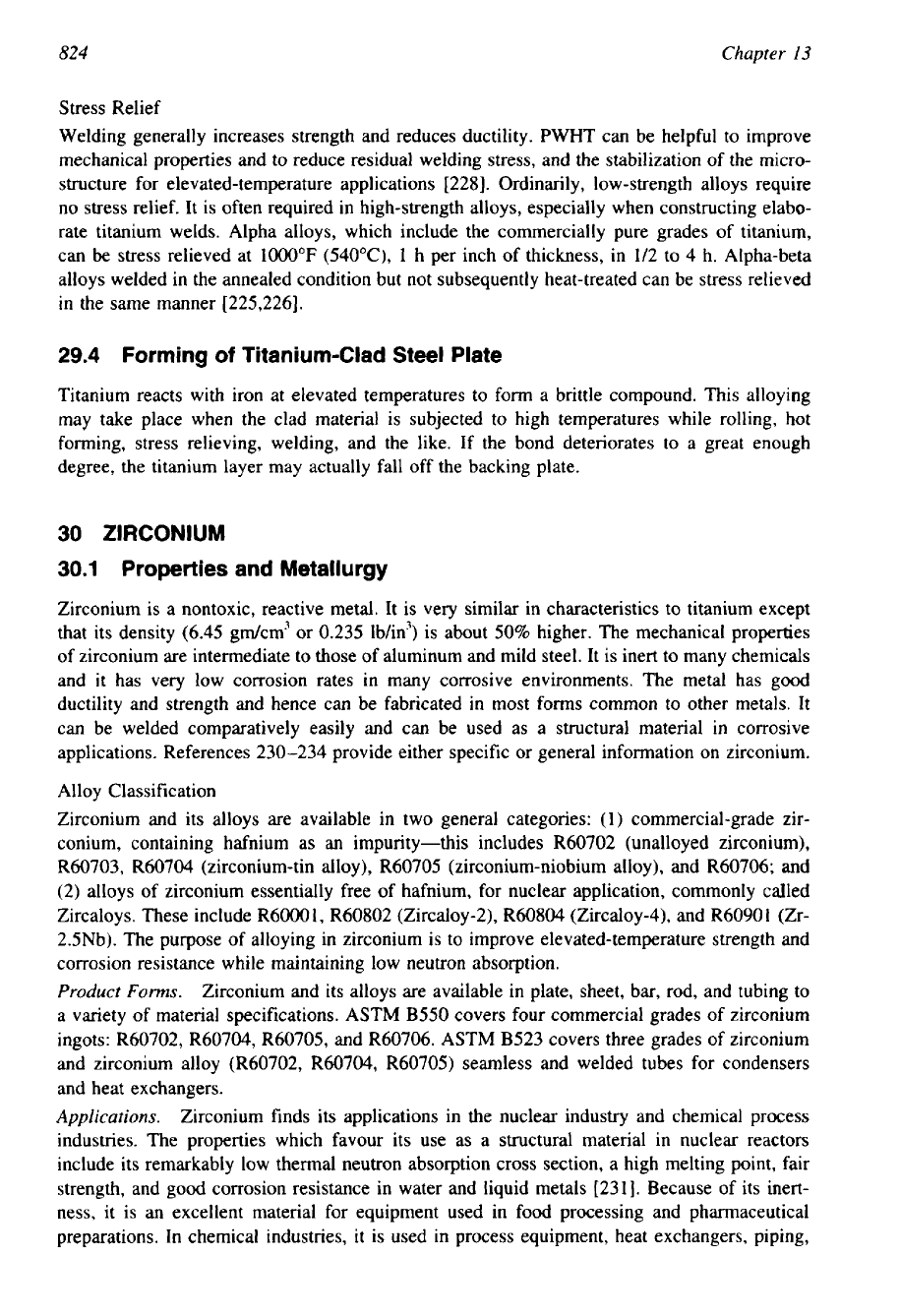
824
Chapter
I3
Stress Relief
Welding generally increases strength and reduces ductility. PWHT can be helpful to improve
mechanical properties and to reduce residual welding stress, and the stabilization of the micro-
structure for elevated-temperature applications [228]. Ordinarily, low-strength alloys require
no stress relief. It is often required in high-strength alloys, especially when constructing elabo-
rate titanium welds. Alpha alloys, which include the commercially pure grades of titanium,
can
be
stress relieved at 1000°F (540°C), 1 h per inch of thickness, in 1/2 to
4
h. Alpha-beta
alloys welded in the annealed condition but not subsequently heat-treated can be stress relieved
in the same manner [225,226].
29.4
Forming of Titanium-Clad Steel Plate
Titanium reacts with iron at elevated temperatures to form
a
brittle compound. This alloying
may take place when the clad material is subjected to high temperatures while rolling, hot
forming, stress relieving, welding, and the like. If the bond deteriorates to a great enough
degree, the titanium layer may actually fall off the backing plate.
30
ZIRCONIUM
30.1
Properties
and Metallurgy
Zirconium is a nontoxic, reactive metal. It is very similar in characteristics to titanium except
that its density (6.45 gm/cm2 or 0.235 lbhn') is about
50%
higher. The mechanical properties
of zirconium are intermediate to those
of
aluminum and mild steel. It is inert to many chemicals
and it has very low corrosion rates in many corrosive environments. The metal has good
ductility and strength and hence can be fabricated in most forms common to other metals. It
can be welded comparatively easily and can be used as a structural material in corrosive
applications. References 230-234 provide either specific or general information on zirconium.
Alloy Classification
Zirconium and its alloys are available in two general categories:
(1)
commercial-grade zir-
conium, containing hafnium as an impurity-this includes R60702 (unalloyed zirconium),
R60703, R60704 (zirconium-tin alloy), R60705 (zirconium-niobium alloy), and R60706;
and
(2) alloys of zirconium essentially free of hafnium, for nuclear application, commonly called
Zircaloys. These include R6W1, R60802 (Zircaloy-2), R60804 (Zircaloy-4), and
R6090
1
(Zr-
23%). The purpose of alloying in zirconium is to improve elevated-temperature strength and
corrosion resistance while maintaining low neutron absorption.
Product
Forms.
Zirconium and its alloys are available in plate, sheet, bar, rod, and tubing to
a variety of material specifications. ASTM
B550
covers four commercial grades of zirconium
ingots: R60702, R60704, R60705, and R60706. ASTM B523 covers three grades of zirconium
and zirconium alloy (R60702, R60704, R60705) seamless and welded tubes for condensers
and heat exchangers.
Applications.
Zirconium finds its applications in the nuclear industry and chemical process
industries, The properties which favour its use as a structural material in nuclear reactors
include its remarkably low thermal neutron absorption cross section, a high melting point, fair
strength, and good corrosion resistance in water and liquid metals [231]. Because
of
its inert-
ness, it is
an
excellent material for equipment used in food processing and pharmaceutical
preparations. In chemical industries,
it
is used in process equipment, heat exchangers, piping,
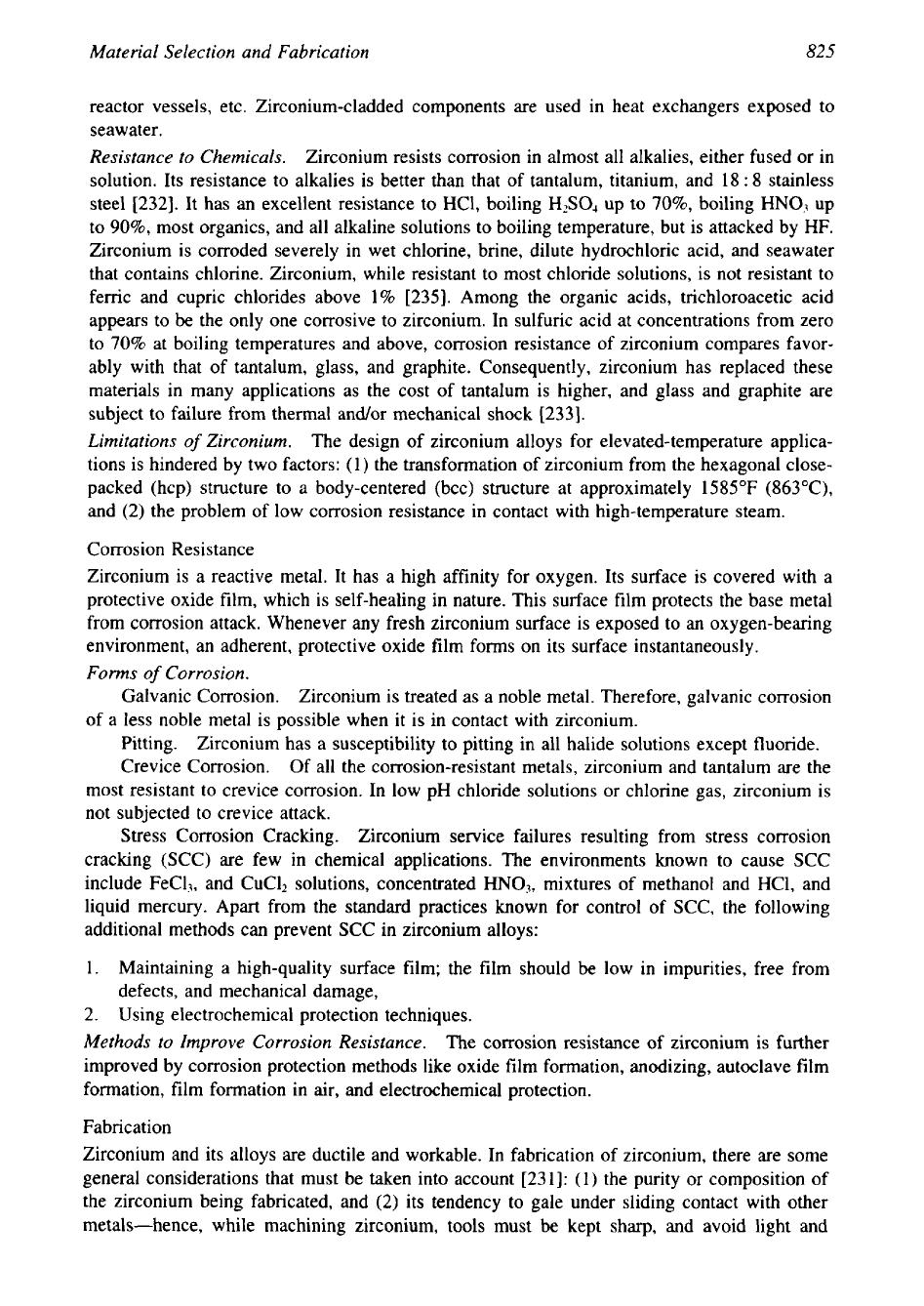
825
Material Selection and Fabrication
reactor vessels, etc. Zirconium-cladded components are used in heat exchangers exposed to
seawater.
Resistance to Chemicals.
Zirconium resists corrosion in almost all alkalies, either fused or in
solution. Its resistance to alkalies is better than that of tantalum, titanium, and 18
:
8 stainless
steel [232]. It has an excellent resistance to HC1, boiling H,SO, up to
70%,
boiling HNO, up
to
90%,
most organics, and all alkaline solutions to boiling temperature, but is attacked by HF.
Zirconium is corroded severely in wet chlorine, brine, dilute hydrochloric acid, and seawater
that contains chlorine. Zirconium, while resistant to most chloride solutions, is not resistant to
ferric and cupric chlorides above
1%
[235]. Among the organic acids, trichloroacetic acid
appears to be the only one corrosive to zirconium. In sulfuric acid at concentrations from zero
to
70%
at boiling temperatures and above, corrosion resistance of zirconium compares favor-
ably with that of tantalum, glass, and graphite. Consequently, zirconium has replaced these
materials in many applications as the cost of tantalum is higher, and glass and graphite are
subject to failure from thermal andor mechanical shock [233].
Limitations
of
Zirconium.
The design of zirconium alloys for elevated-temperature applica-
tions is hindered by two factors: (1) the transformation of zirconium from the hexagonal close-
packed (hcp) structure to
a
body-centered (bcc) structure at approximately 1585°F (863"C),
and
(2)
the problem of low corrosion resistance in contact with high-temperature steam.
Corrosion Resistance
Zirconium is a reactive metal. It has a high affinity for oxygen. Its surface is covered with a
protective oxide film, which is self-healing in nature. This surface film protects the base metal
from corrosion attack. Whenever any fresh zirconium surface is exposed to an oxygen-bearing
environment, an adherent, protective oxide film forms on its surface instantaneously.
Forms
of
Corrosion.
Galvanic Corrosion.
Zirconium is treated as a noble metal. Therefore, galvanic corrosion
of a less noble metal is possible when it is in contact with zirconium.
Pitting. Zirconium has a susceptibility to pitting in all halide solutions except fluoride.
Crevice Corrosion.
Of all the corrosion-resistant metals, zirconium and tantalum are the
most resistant to crevice corrosion. In low pH chloride solutions or chlorine gas, zirconium is
not subjected to crevice attack.
Stress Corrosion Cracking.
Zirconium service failures resulting from stress corrosion
cracking (SCC) are few in chemical applications.
The
environments known to cause SCC
include FeCl,, and CuC12 solutions, concentrated
HN03,
mixtures of methanol and HCl, and
liquid mercury. Apart from the standard practices known for control of SCC, the following
additional methods can prevent
SCC
in zirconium alloys:
1.
Maintaining a high-quality surface film; the film should be low in impurities, free from
defects, and mechanical damage,
2. Using electrochemical protection techniques.
Methods to Improve
Corrosion
Resistance.
The corrosion resistance of zirconium is further
improved by corrosion protection methods like oxide film formation, anodizing, autoclave film
formation, film formation in air, and electrochemical protection.
Fabrication
Zirconium and its alloys are ductile and workable. In fabrication of zirconium, there are some
general considerations that must be taken into account [231]:
(1)
the purity
or
composition of
the zirconium being fabricated, and (2) its tendency to gale under sliding contact with other
metals-hence, while machining zirconium, tools must be kept sharp, and avoid light and
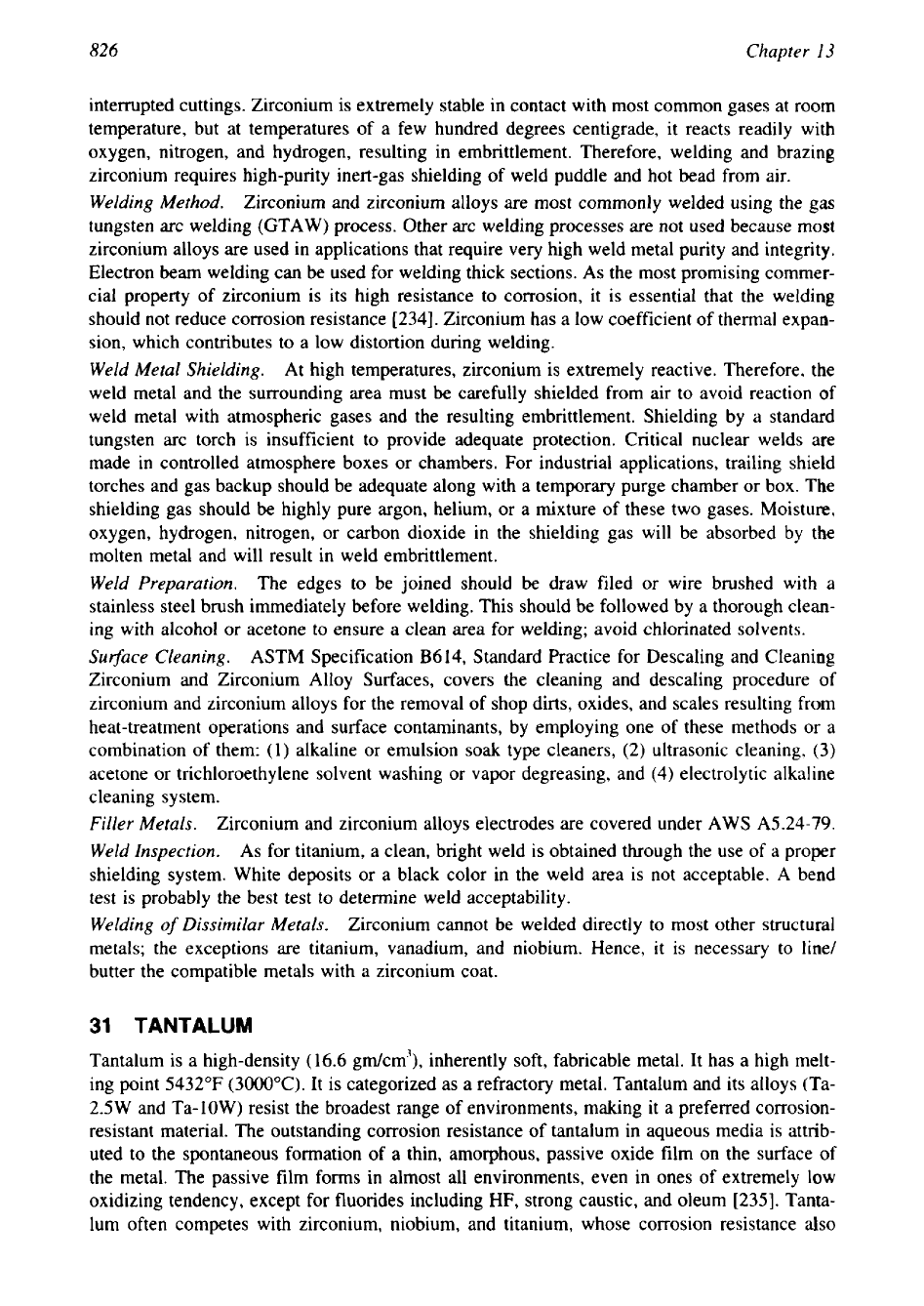
826
Chapter
13
interrupted cuttings. Zirconium is extremely stable in contact with most common gases at room
temperature, but at temperatures of a few hundred degrees centigrade, it reacts readily with
oxygen, nitrogen, and hydrogen, resulting in embrittlement. Therefore, welding and brazing
zirconium requires high-purity inert-gas shielding of weld puddle and hot bead from air.
Welding Method.
Zirconium and zirconium alloys are most commonly welded using the gas
tungsten arc welding (GTAW) process. Other arc welding processes are not used because most
zirconium alloys are used in applications that require very high weld metal purity and integrity.
Electron beam welding can be used for welding thick sections. As the most promising commer-
cial property of zirconium is its high resistance to corrosion, it is essential that the welding
should not reduce corrosion resistance
[234].
Zirconium has a low coefficient of thermal expan-
sion, which contributes to a low distortion during welding.
Weld Metal Shielding.
At high temperatures, zirconium is extremely reactive. Therefore, the
weld metal and the surrounding area must be carefully shielded from air to avoid reaction of
weld metal with atmospheric gases and the resulting embrittlement. Shielding by a standard
tungsten arc torch is insufficient to provide adequate protection. Critical nuclear welds are
made in controlled atmosphere boxes
or
chambers. For industrial applications, trailing shield
torches and gas backup should be adequate along with a temporary purge chamber or box. The
shielding gas should be highly pure argon, helium, or a mixture of these two gases. Moistum,
oxygen, hydrogen, nitrogen, or carbon dioxide in the shielding gas will be absorbed by the
molten metal and will result in weld embrittlement.
Weld Preparation.
The edges to be joined should be draw filed or wire brushed with a
stainless steel brush immediately before welding. This should be followed by a thorough clean-
ing with alcohol or acetone to ensure a clean area for welding; avoid chlorinated solvents.
Su@ace
Cleaning.
ASTM Specification
B6
14,
Standard Practice for Descaling and Cleaning
Zirconium and Zirconium Alloy Surfaces, covers the cleaning and descaling procedure of
zirconium and zirconium alloys for the removal of shop dirts, oxides, and scales resulting from
heat-treatment operations and surface contaminants, by employing one of these methods or a
combination of them:
(1)
alkaline or emulsion
soak
type cleaners, (2) ultrasonic cleaning.
(3)
acetone or trichloroethylene solvent washing or vapor degreasing, and (4) electrolytic alkaline
cleaning system.
Filler Metals.
Zirconium and zirconium alloys electrodes are covered under AWS A5.24-79.
Weld Inspection.
As for titanium, a clean, bright weld is obtained through the use of a proper
shielding system. White deposits or a black color in the weld area is not acceptable. A bend
test is probably the best test
to
determine weld acceptability.
Welding
of
Dissimilar Metals.
Zirconium cannot be welded directly to most other structural
metals; the exceptions are titanium, vanadium, and niobium. Hence,
it
is necessary to line/
butter the compatible metals with a zirconium coat.
31
TANTALUM
Tantalum is a high-density (16.6 gm/cm3), inherently soft, fabricable metal. It has a high melt-
ing point 5432°F (3000°C). It is categorized as a refractory metal. Tantalum and its alloys (Ta-
2.5W and Ta-IOW) resist the broadest range of environments, making it a preferred corrosion-
resistant material. The outstanding corrosion resistance of tantalum in aqueous media is attrib-
uted to the spontaneous formation
of
a thin, amorphous, passive oxide film on the surface of
the metal. The passive film forms in almost all environments, even in ones of extremely low
oxidizing tendency, except for fluorides including
HF,
strong caustic, and oleum
[235].
Tanta-
lum often competes with zirconium, niobium, and titanium, whose corrosion resistance
also
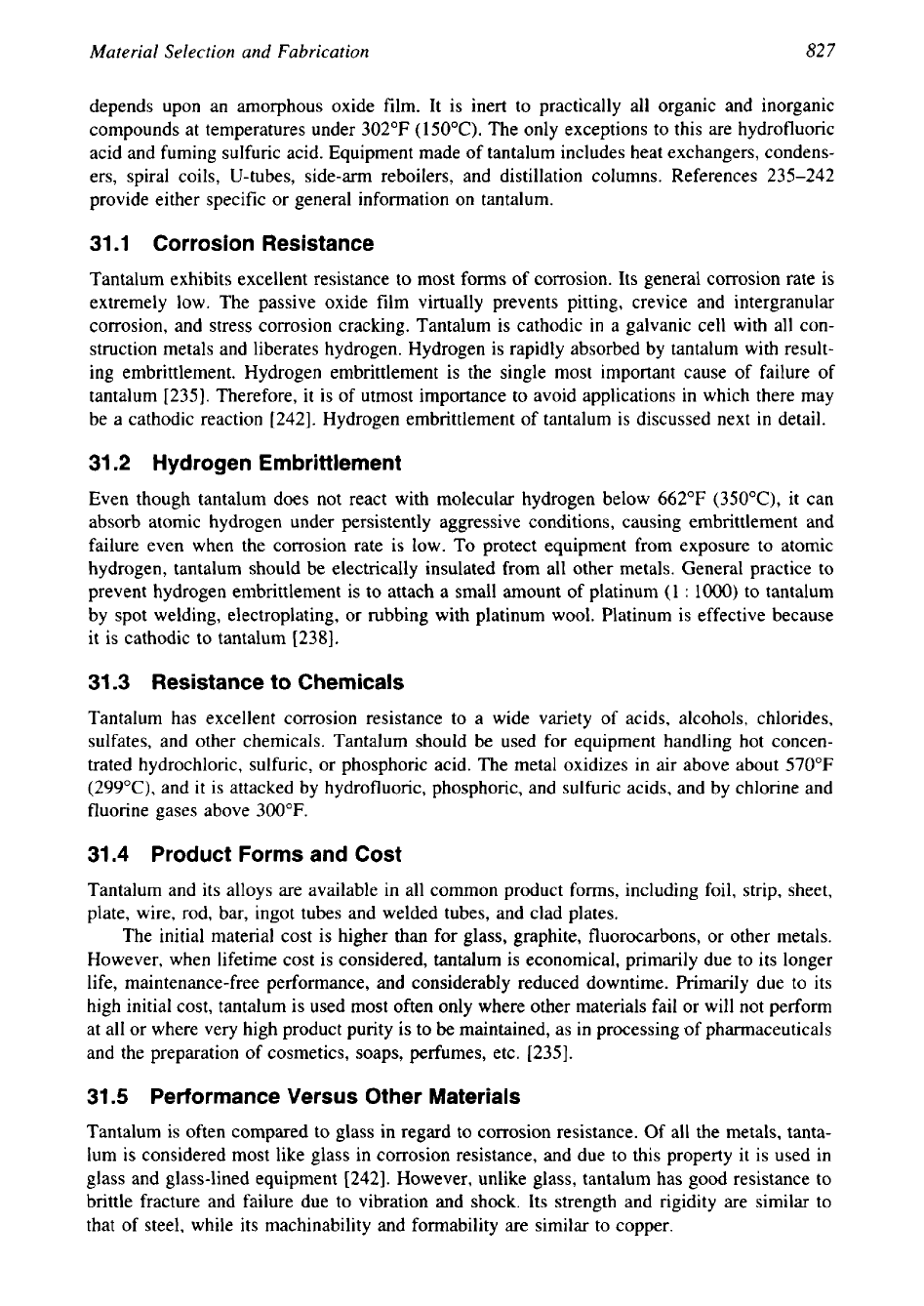
Material Selection and Fabrication
82
7
depends upon an amorphous oxide film. It is inert to practically all organic and inorganic
compounds at temperatures under 302°F
(150°C).
The only exceptions to this are hydrofluoric
acid and fuming sulfuric acid. Equipment made of tantalum includes heat exchangers, condens-
ers, spiral coils, U-tubes, side-arm reboilers, and distillation columns. References 235-242
provide either specific or general information on tantalum.
31
.I
Corrosion Resistance
Tantalum exhibits excellent resistance to most
forms
of corrosion. Its general corrosion rate is
extremely low. The passive oxide film virtually prevents pitting, crevice and intergranular
corrosion, and stress corrosion cracking. Tantalum is cathodic in a galvanic cell with all con-
struction metals and liberates hydrogen. Hydrogen is rapidly absorbed by tantalum with result-
ing embrittlement. Hydrogen embrittlement is the single most important cause of failure of
tantalum [235]. Therefore, it is
of
utmost importance to avoid applications in which there may
be a cathodic reaction [242]. Hydrogen embrittlement of tantalum is discussed next in detail.
31.2 Hydrogen Embrittlement
Even though tantalum does not react with molecular hydrogen below
662°F
(350"C), it can
absorb atomic hydrogen under persistently aggressive conditions, causing embrittlement and
failure even when the corrosion rate is low. To protect equipment from exposure to atomic
hydrogen, tantalum should be electrically insulated from all other metals. General practice to
prevent hydrogen embrittlement is to attach a small amount of platinum
(1
:
10o0)
to tantalum
by spot welding, electroplating, or rubbing with platinum wool. Platinum is effective because
it is cathodic to tantalum [238].
31.3 Resistance to Chemicals
Tantalum has excellent corrosion resistance to a wide variety
of
acids, alcohols, chlorides,
sulfates, and other chemicals. Tantalum should be used for equipment handling hot concen-
trated hydrochloric, sulfuric, or phosphoric acid. The metal oxidizes in air above about
570°F
(299"C), and it is attacked by hydrofluoric, phosphoric, and sulfuric acids, and by chlorine and
fluorine gases above
300°F.
31.4 Product Forms and Cost
Tantalum and its alloys are available in all common product forms, including foil, strip, sheet,
plate, wire, rod, bar, ingot tubes and welded tubes, and clad plates.
The initial material cost is higher than for glass, graphite, fluorocarbons, or other metals.
However, when lifetime cost is considered, tantalum is economical, primarily due to its longer
life, maintenance-free performance, and considerably reduced downtime. Primarily due to its
high initial cost, tantalum is used most often only where other materials fail or will not perform
at all or where very high product purity is to
be
maintained, as in processing of pharmaceuticals
and the preparation of cosmetics, soaps, perfumes, etc. [235].
31.5 Performance Versus Other Materials
Tantalum is often compared to glass in regard to corrosion resistance. Of all the metals, tanta-
lum is considered most like glass in corrosion resistance, and due to this property it is used in
glass and glass-lined equipment [242]. However, unlike glass, tantalum has good resistance to
brittle fracture and failure due to vibration and shock. Its strength and rigidity are similar to
that of steel, while its machinability and formability are similar to copper.
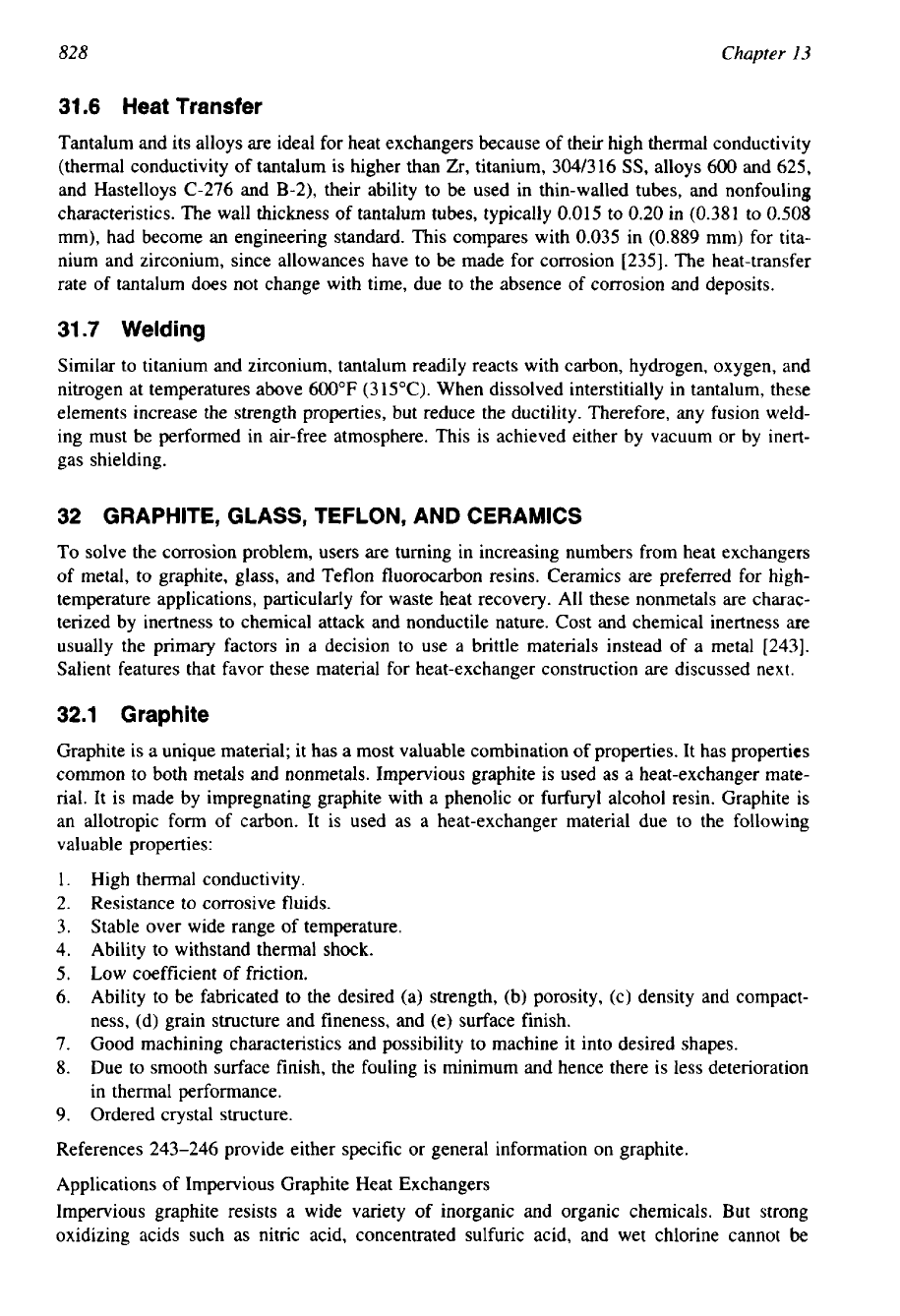
828
Chapter
I3
31.6 Heat Transfer
Tantalum and its alloys are ideal for heat exchangers because of their high thermal conductivity
(thermal conductivity of tantalum is higher than Zr, titanium,
304/316
SS,
alloys
600
and
625,
and Hastelloys C-276 and B-2), their ability to be used in thin-walled tubes, and nonfouling
characteristics. The wall thickness of tantalum
tubes,
typically 0.015 to
0.20
in
(0.381
to
0.508
mm), had become an engineering standard. This compares with
0.035
in
(0.889
mm) for tita-
nium and zirconium, since allowances have to be made for corrosion
[235].
The heat-transfer
rate of tantalum does not change with time, due to the absence of corrosion and deposits.
31.7 Welding
Similar to titanium and zirconium, tantalum readily reacts with carbon, hydrogen, oxygen, and
nitrogen at temperatures above
600°F
(3
15°C). When dissolved interstitially in tantalum, these
elements increase the strength properties, but reduce the ductility. Therefore,
any
fusion weld-
ing must be performed in air-free atmosphere. This is achieved either by vacuum or by inert-
gas shielding.
32
GRAPHITE, GLASS, TEFLON, AND CERAMICS
To
solve the corrosion problem, users are turning in increasing numbers from heat exchangers
of metal, to graphite, glass, and Teflon fluorocarbon resins. Ceramics are preferred for high-
temperature applications, particularly for waste heat recovery. All these nonmetals are charac-
terized by inertness to chemical attack and nonductile nature. Cost and chemical inertness are
usually the primary factors in a decision to use a brittle materials instead of a metal
[243].
Salient features that favor these material for heat-exchanger construction are discussed next.
32.1 Graphite
Graphite is a unique material; it has a most valuable combination of properties. It has properties
common
to
both metals and nonmetals. Impervious graphite is used as a heat-exchanger mate-
rial. It is made by impregnating graphite with a phenolic or furfuryl alcohol resin. Graphite is
an allotropic form of carbon. It is used as a heat-exchanger material due to the following
valuable properties:
1,
High thermal conductivity.
2.
Resistance
to
corrosive fluids.
3.
Stable over wide range of temperature.
4.
Ability to withstand thermal shock.
5.
Low coefficient of friction.
6.
Ability to be fabricated to the desired (a) strength, (b) porosity, (c) density and compact-
ness, (d) grain structure and fineness, and (e) surface finish.
7.
Good machining characteristics and possibility to machine it into desired shapes.
8.
Due to smooth surface finish, the fouling is minimum and hence there is less deterioration
in thermal performance.
9.
Ordered crystal structure.
References
243-246
provide either specific or general information on graphite.
Applications of Impervious Graphite Heat Exchangers
Impervious graphite resists a wide variety of inorganic and organic chemicals. But strong
oxidizing acids such as nitric acid, concentrated sulfuric acid, and wet chlorine cannot be
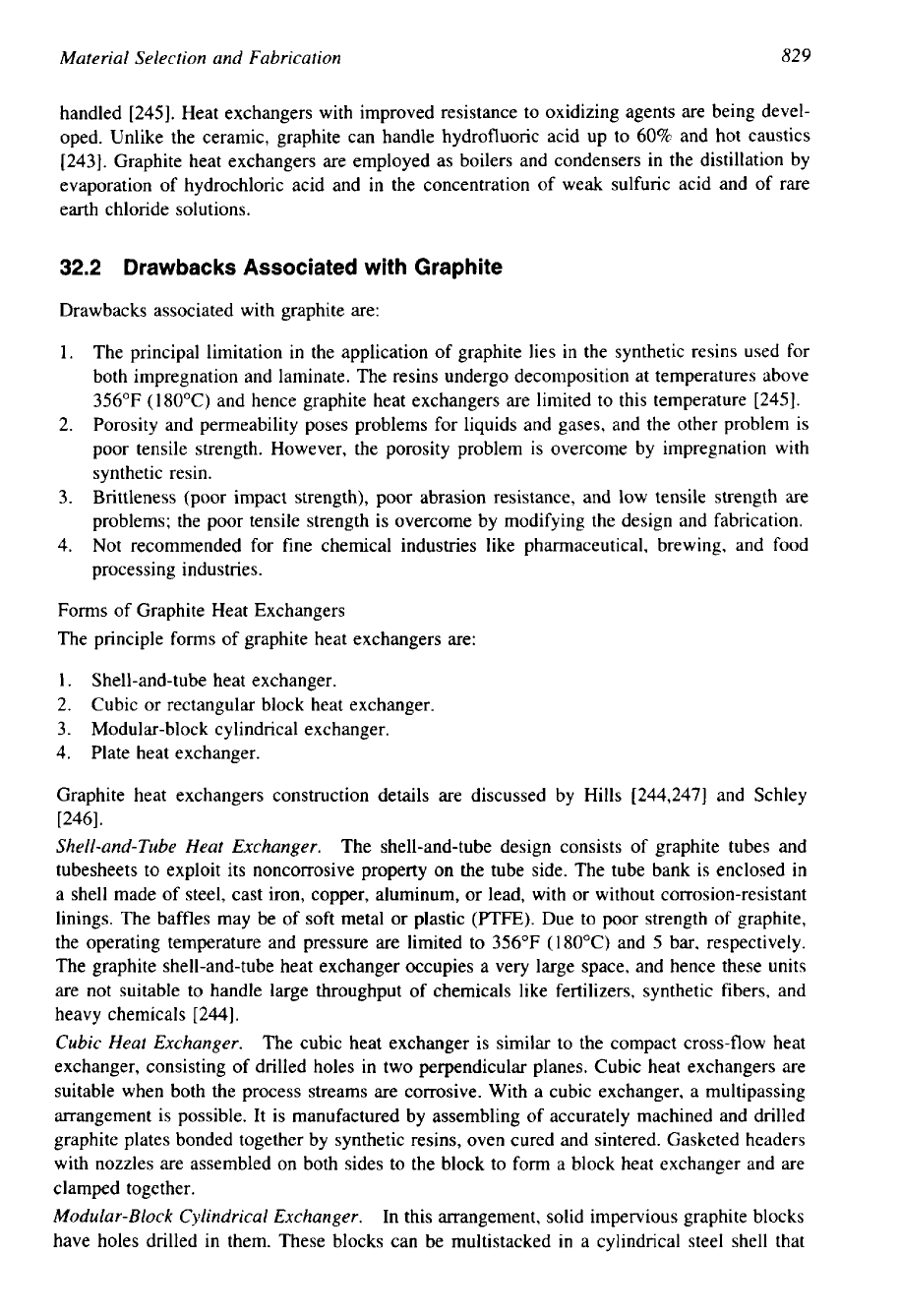
Material Selection and Fabrication
829
handled [245]. Heat exchangers with improved resistance to oxidizing agents are being devel-
oped. Unlike the ceramic, graphite can handle hydrofluoric acid up to
60%
and hot caustics
[243]. Graphite heat exchangers are employed as boilers and condensers in the distillation by
evaporation of hydrochloric acid and in the concentration of weak sulfuric acid and of rare
earth chloride solutions.
32.2
Drawbacks Associated with Graphite
Drawbacks associated with graphite are:
1.
The principal limitation in the application of graphite lies
in
the synthetic resins used for
both impregnation and laminate. The resins undergo decomposition at temperatures above
356°F
(180°C) and hence graphite heat exchangers are limited to this temperature [245].
2.
Porosity and permeability poses problems for liquids and gases, and the other problem is
poor tensile strength. However, the porosity problem is overcome by impregnation with
synthetic resin.
3.
Brittleness (poor impact strength), poor abrasion resistance, and low tensile strength are
problems; the poor tensile strength is overcome by modifying the design and fabrication.
4.
Not recommended for fine chemical industries like pharmaceutical, brewing, and food
processing industries.
Forms of Graphite Heat Exchangers
The principle forms of graphite heat exchangers are:
1.
Shell-and-tube heat exchanger.
2.
Cubic or rectangular block heat exchanger.
3.
Modular-block cylindrical exchanger.
4. Plate heat exchanger.
Graphite heat exchangers construction details are discussed by Hills [244,247] and Schley
[
2461.
Shell-and-Tube Heat Exchanger.
The shell-and-tube design consists of graphite tubes and
tubesheets to exploit its noncorrosive property on the tube side. The tube bank is enclosed in
a shell made of steel, cast iron, copper, aluminum, or lead, with or without corrosion-resistant
linings. The baffles may be of soft metal or plastic (PTFE). Due to poor strength of graphite,
the operating temperature and pressure are limited to
356°F
(180°C) and
5
bar, respectively.
The graphite shell-and-tube heat exchanger occupies a very large space, and hence these units
are not suitable to handle large throughput
of
chemicals like fertilizers, synthetic fibers, and
heavy chemicals [244].
Cubic Heat Exchanger.
The cubic heat exchanger is similar to the compact cross-flow heat
exchanger, consisting
of
drilled holes in two perpendicular planes. Cubic heat exchangers are
suitable when both the process streams are corrosive. With a cubic exchanger, a multipassing
arrangement is possible. It is manufactured by assembling of accurately machined and drilled
graphite plates bonded together by synthetic resins, oven cured and sintered. Gasketed headers
with nozzles are assembled on both sides
to
the block to form a block heat exchanger and are
clamped together.
Modular-Block Cylindrical Exchanger.
In this arrangement, solid impervious graphite blocks
have holes drilled in them. These blocks can be multistacked
in
a cylindrical steel shell that
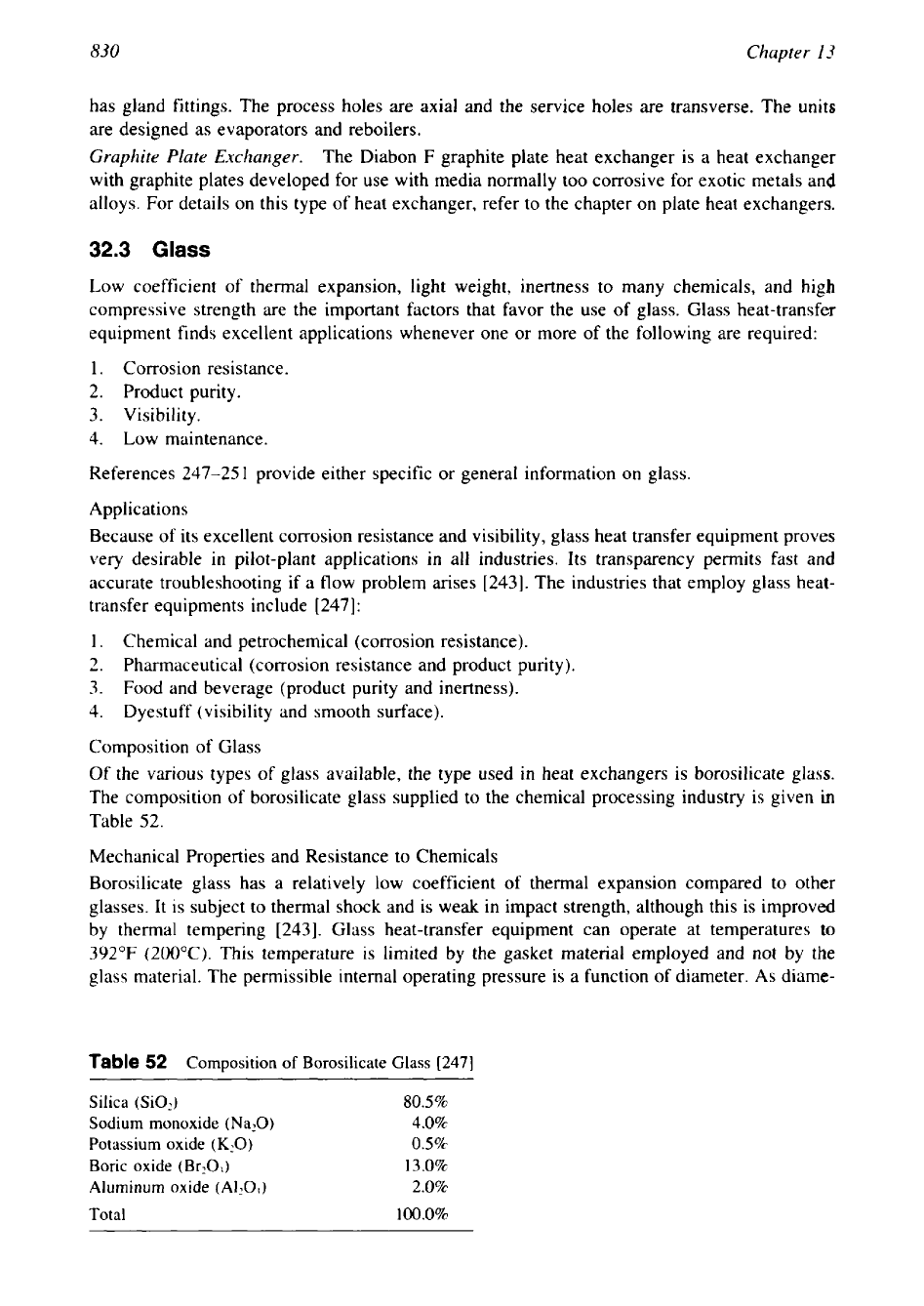
830
Chapter
I3
has gland fittings. The process holes are axial and the service holes are transverse. The units
are designed as evaporators and reboilers.
Graphite Plate Exchanger.
The Diabon
F
graphite plate heat exchanger is a heat exchanger
with graphite plates developed for use with media normally too corrosive for exotic metals and
alloys. For details on this type of heat exchanger, refer to the chapter on plate heat exchangers.
32.3
Glass
Low coefficient of thermal expansion, light weight, inertness to many chemicals, and high
compressive strength are the important factors that favor the use of glass. Glass heat-transfer
equipment finds excellent applications whenever one or more of the following are required:
1.
Corrosion resistance.
2. Product purity.
3.
Visibility.
4. Low maintenance.
References 247-25
1
provide either specific or general information on glass.
Applications
Because of its excellent corrosion resistance and visibility, glass heat transfer equipment proves
very desirable in pilot-plant applications in all industries. Its transparency permits fast and
accurate troubleshooting if a flow problem arises [243]. The industries that employ glass heat-
transfer equipments include [247]:
1.
Chemical and petrochemical (corrosion resistance).
2.
Pharmaceutical (corrosion resistance and product purity).
3.
Food and beverage (product purity and inertness).
4.
Dyestuff (visibility and smooth surface).
Composition of Glass
Of
the various types of glass available, the type used
in
heat exchangers is borosilicate glass.
The composition
of
borosilicate glass supplied to the chemical processing industry is given
in
Table
52.
Mechanical Properties and Resistance to Chemicals
Borosilicate glass has a relatively low coefficient of thermal expansion compared to other
glasses. It is subject to thermal shock and
is
weak
in impact strength, although this is improved
by thermal tempering [243]. Glass heat-transfer equipment can operate at temperatures
to
392°F (200°C). This temperature is limited by the gasket material employed and not by the
glass material. The permissible internal operating pressure is a function of diameter. As diame-
Table
52
Composition
of
Borosilicate Glass
[247]
Silica
(SiO?)
80.5%
Sodium monoxide (Na20)
4.0%
Potassium oxide
(K20)
0.5%
Boric
oxide
(Br,O,)
13.0%
Aluminurn oxide (A120i)
2.0%
Total
100.0%
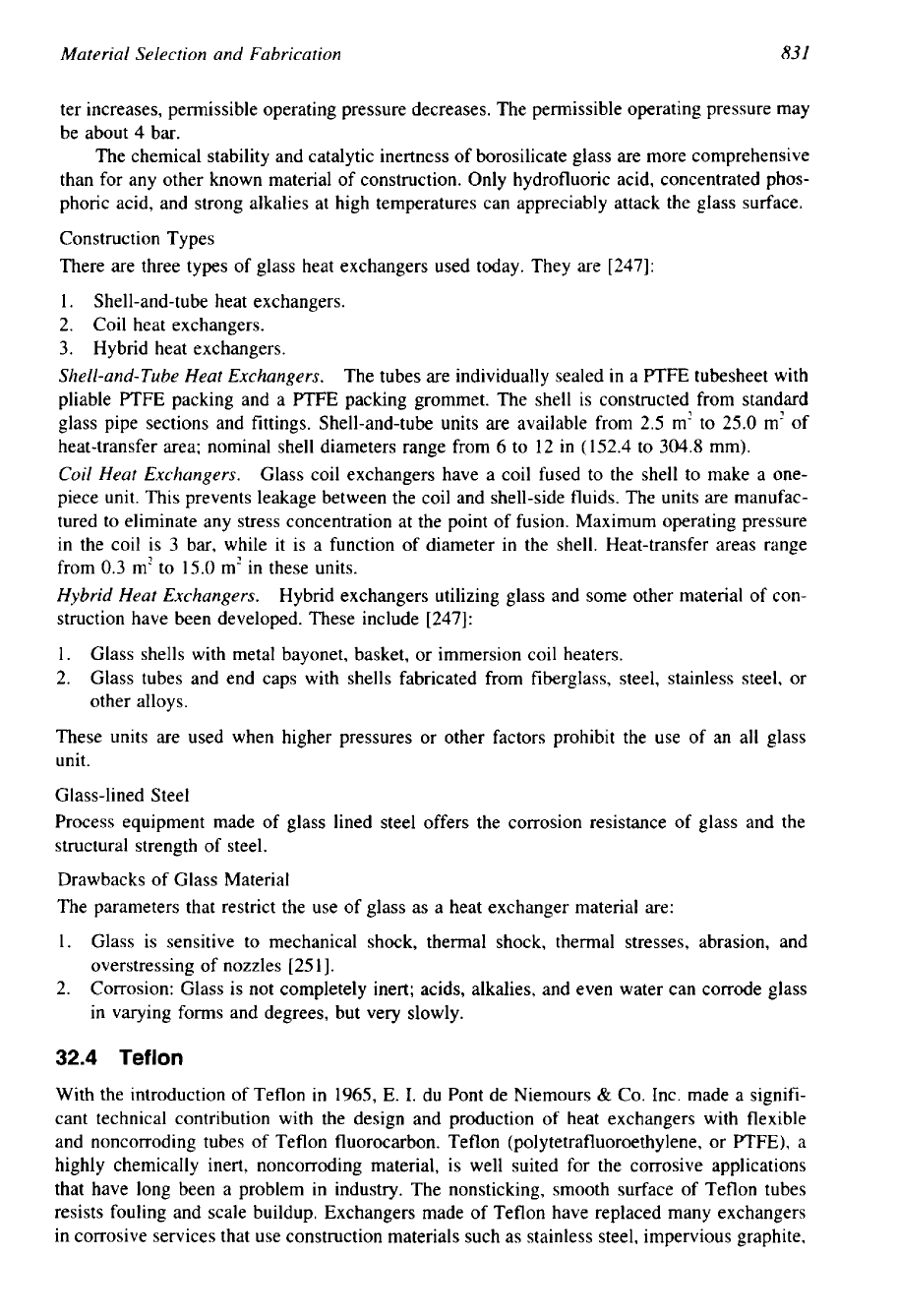
Material Selection and Fabrication
831
ter increases, permissible operating pressure decreases. The permissible operating pressure may
be about 4 bar.
The chemical stability and catalytic inertness of borosilicate glass are more comprehensive
than for any other known material of construction. Only hydrofluoric acid, concentrated phos-
phoric acid, and strong alkalies at high temperatures can appreciably attack the glass surface.
Construction Types
There are three types of glass heat exchangers used today. They are
[247]:
1. Shell-and-tube heat exchangers.
2.
Coil heat exchangers.
3. Hybrid heat exchangers.
Shell-and-Tube Heat Exchangers.
The tubes are individually sealed
in
a PTFE tubesheet with
pliable PTFE packing and a PTFE packing grommet. The shell is constructed from standard
glass pipe sections and fittings. Shell-and-tube units are available from
2.5
m’ to
25.0
m’ of
heat-transfer area; nominal shell diameters range from
6
to 12
in
(152.4 to 304.8 mm).
Coil
Heat Exchangers.
Glass coil exchangers have a coil fused to the shell to make a one-
piece unit. This prevents leakage between the coil and shell-side fluids. The units are manufac-
tured to eliminate any stress concentration at the point of fusion. Maximum operating pressure
in the coil is 3 bar, while it is a function of diameter in the shell. Heat-transfer areas range
from
0.3
m’ to
15.0
m’ in these units.
Hybrid Heat Exchangers.
Hybrid exchangers utilizing glass and some other material of con-
struction have been developed. These include [247]:
1.
Glass shells with metal bayonet, basket, or immersion coil heaters.
2.
Glass tubes and end caps with shells fabricated from fiberglass, steel, stainless steel, or
other alloys.
These units are used when higher pressures or other factors prohibit the use of
an
all glass
unit.
Glass-lined Steel
Process equipment made of glass lined steel offers the corrosion resistance of glass and the
structural strength of steel.
Drawbacks of Glass Material
The parameters that restrict the use of glass as a heat exchanger material are:
1.
Glass is sensitive to mechanical shock, thermal shock, thermal stresses, abrasion, and
overstressing of nozzles [25 11.
2.
Corrosion: Glass is not completely inert; acids, alkalies, and even water can corrode glass
in varying forms and degrees, but very slowly.
32.4
Teflon
With the introduction of Teflon in 1965,
E. I.
du Pont de Niemours
&
Co. Inc. made a signifi-
cant technical contribution with the design and production of heat exchangers with flexible
and noncorroding tubes of Teflon fluorocarbon. Teflon
(polytetrafluoroethylene,
or PTFE), a
highly chemically inert, noncorroding material, is well suited for the corrosive applications
that have long been a problem in industry. The nonsticking, smooth surface of Teflon tubes
resists fouling and scale buildup. Exchangers made of Teflon have replaced many exchangers
in corrosive services that use construction materials such as stainless steel, impervious graphite,
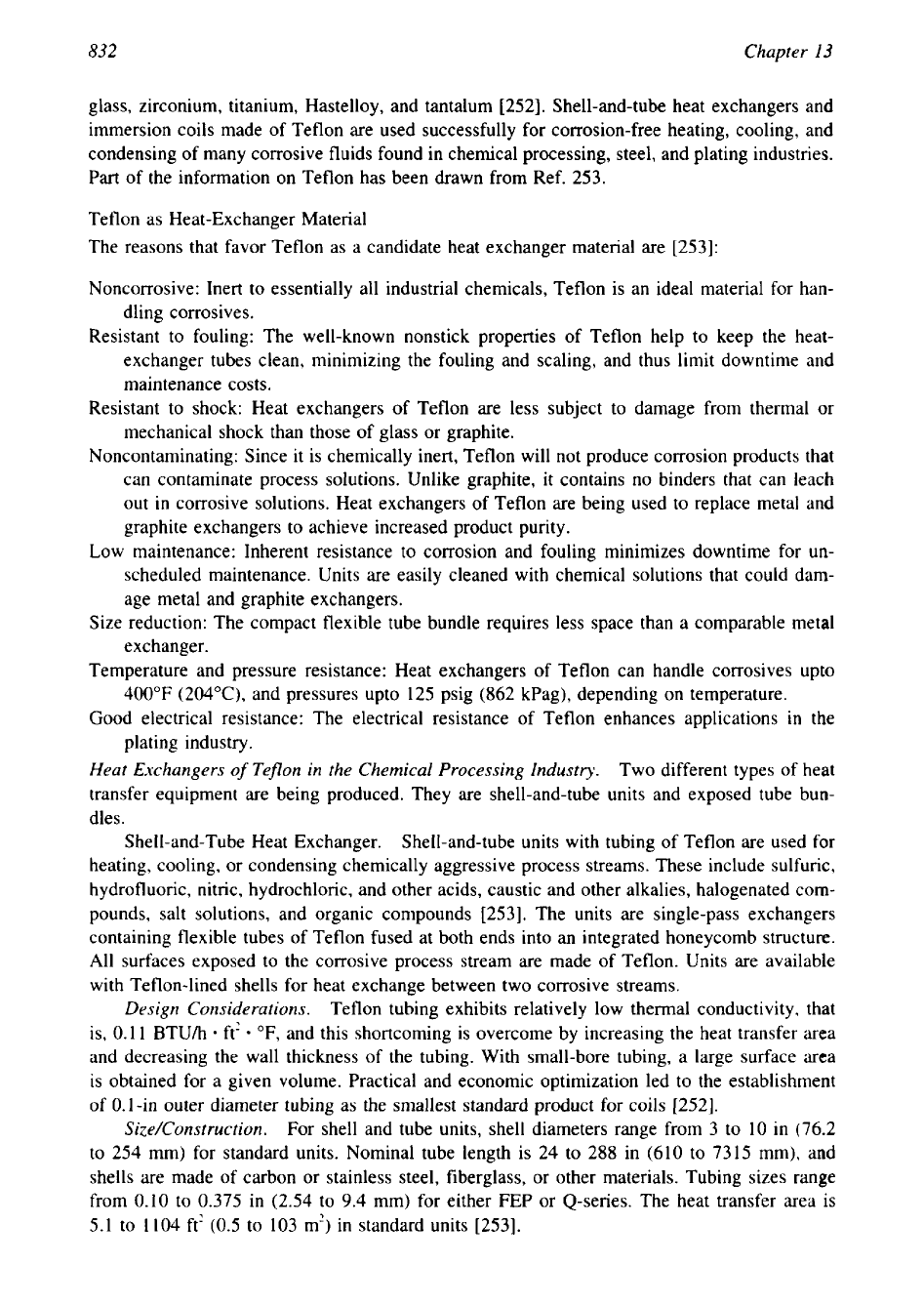
832
Chapter
I3
glass, zirconium, titanium, Hastelloy, and tantalum
[252].
Shell-and-tube heat exchangers and
immersion coils made of Teflon are used successfully for corrosion-free heating, cooling, and
condensing of many corrosive fluids found in chemical processing, steel, and plating industries.
Part of the information on Teflon has been drawn from Ref.
253.
Teflon as Heat-Exchanger Material
The reasons that favor Teflon as a candidate heat exchanger material are
[253]:
Noncorrosive: Inert to essentially all industrial chemicals, Teflon is an ideal material for han-
dling corrosives.
Resistant to fouling: The well-known nonstick properties of Teflon help to keep the heat-
exchanger tubes clean, minimizing the fouling and scaling, and thus limit downtime and
maintenance costs.
Resistant to shock: Heat exchangers of Teflon are less subject to damage from thermal or
mechanical shock than those of glass or graphite.
Noncontaminating: Since it is chemically inert, Teflon will not produce corrosion products that
can contaminate process solutions. Unlike graphite, it contains no binders that can leach
out in corrosive solutions. Heat exchangers of Teflon are being used to replace metal and
graphite exchangers to achieve increased product purity.
Low maintenance: Inherent resistance to corrosion and fouling minimizes downtime for un-
scheduled maintenance. Units are easily cleaned with chemical solutions that could dam-
age metal and graphite exchangers.
Size reduction: The compact flexible tube bundle requires less space than a comparable metal
exchanger.
Temperature and pressure resistance: Heat exchangers of Teflon can handle corrosives upto
400°F
(204"C),
and pressures upto
125
psig
(862
kPag), depending on temperature.
Good electrical resistance: The electrical resistance of Teflon enhances applications
in
the
plating industry.
Heat Exchangers
of
Teflon in the Chemical Processing Industry.
Two different types of heat
transfer equipment are being produced. They are shell-and-tube units and exposed tube bun-
dles.
Shell-and-Tube Heat Exchanger.
Shell-and-tube units with tubing of Teflon are used for
heating, cooling, or condensing chemically aggressive process streams. These include sulfuric,
hydrofluoric, nitric, hydrochloric, and other acids, caustic and other alkalies, halogenated corn-
pounds, salt solutions, and organic compounds
[253].
The units are single-pass exchangers
containing flexible tubes of Teflon fused at both ends into
an
integrated honeycomb structure.
All surfaces exposed to the corrosive process stream are made of Teflon. Units are available
with Teflon-lined shells for heat exchange between two corrosive streams.
Design Considerations.
Teflon tubing exhibits relatively low thermal conductivity, that
is,
0.1
1
BTUh
ft'
OF,
and this shortcoming is overcome by increasing the heat transfer area
and decreasing the wall thickness of the tubing. With small-bore tubing, a large surface area
is obtained for a given volume. Practical and economic optimization led to the establishment
of
0.1
-in outer diameter tubing as the smallest standard product for coils
[252].
SizeKonstruction.
For shell and tube units, shell diameters range from
3
to
10
in
(76.2
to
254
mm) for standard units. Nominal tube length is
24
to
288
in
(610
to
7315
mm), and
shells are made of carbon or stainless steel, fiberglass, or other materials. Tubing sizes range
from
0.10
to
0.375
in
(2.54
to
9.4
mm) for either FEP or Q-series. The heat transfer area is
5.1 to
1104
ft'
(0.5
to
103
m') in standard units
[253].
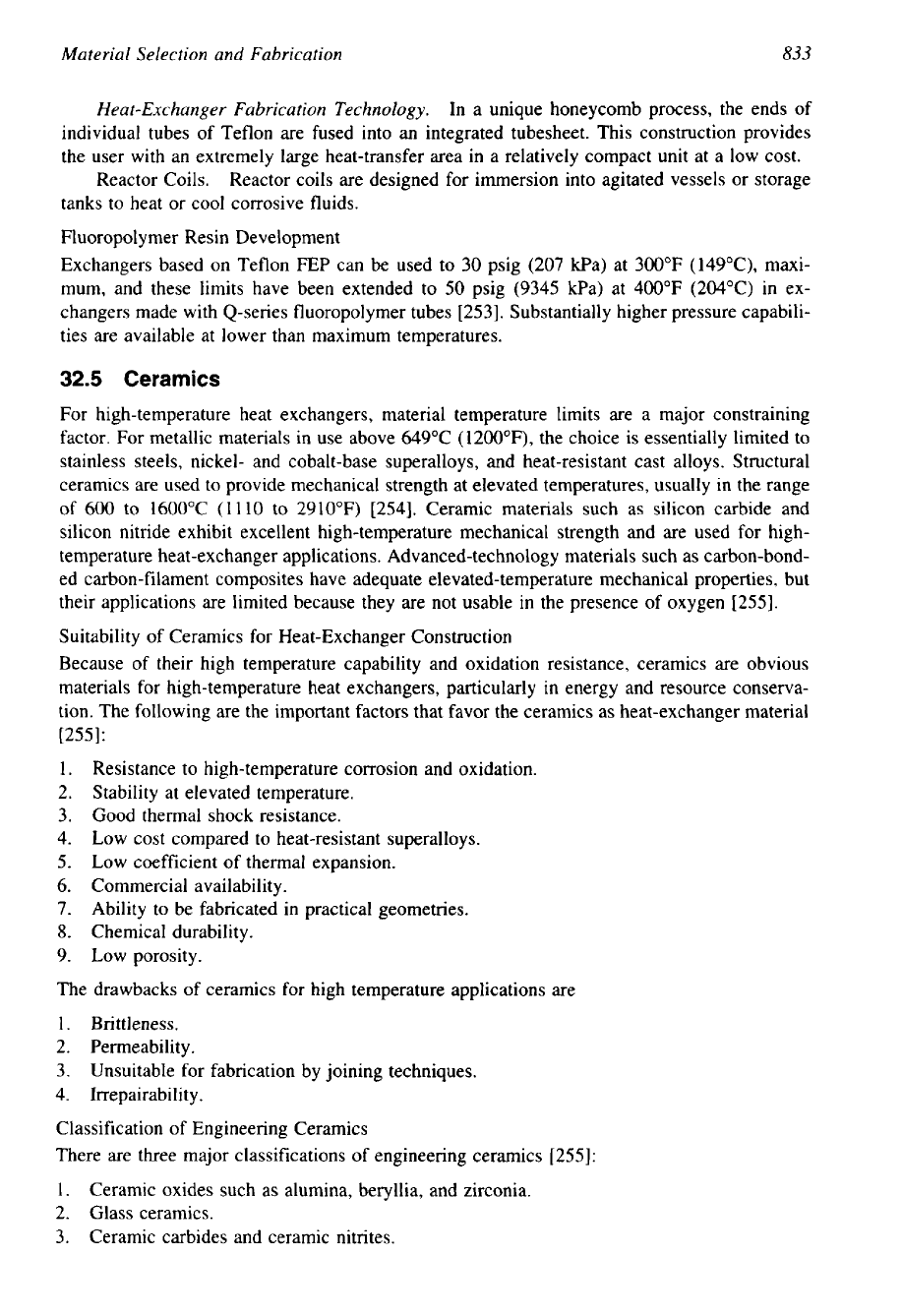
Material Selection and Fabrication
833
Heat-Exchanger Fabrication Technology.
In a unique honeycomb process, the ends of
individual tubes of Teflon are fused into an integrated tubesheet. This construction provides
the user with an extremely large heat-transfer area in a relatively compact unit at a low cost.
Reactor Coils. Reactor coils are designed for immersion into agitated vessels or storage
tanks to heat or cool corrosive fluids.
Fluoropolymer Resin Development
Exchangers based on Teflon FEP can be used to
30
psig (207 kPa) at 300°F (149"C), maxi-
mum, and these limits have been extended to
50
psig (9345 kPa) at 400°F (204°C) in ex-
changers made with Q-series fluoropolymer tubes [253]. Substantially higher pressure capabili-
ties are available at lower than maximum temperatures.
32.5
Ceramics
For high-temperature heat exchangers, material temperature limits are a major constraining
factor. For metallic materials in use above 649°C (1200"F), the choice is essentially limited to
stainless steels, nickel- and cobalt-base superalloys, and heat-resistant cast alloys. Structural
ceramics are used to provide mechanical strength at elevated temperatures, usually in the range
of
600
to
1600°C (1110 to 2910°F) [254]. Ceramic materials such as silicon carbide and
silicon nitride exhibit excellent high-temperature mechanical strength and are used for high-
temperature heat-exchanger applications. Advanced-technology materials such as carbon-bond-
ed carbon-filament composites have adequate elevated-temperature mechanical properties, but
their applications are limited because they are not usable in the presence
of
oxygen
[255].
Suitability of Ceramics for Heat-Exchanger Construction
Because of their high temperature capability and oxidation resistance, ceramics are obvious
materials for high-temperature heat exchangers, particularly in energy and resource conserva-
tion. The following are the important factors that favor the ceramics as heat-exchanger material
[255]:
1.
Resistance to high-temperature corrosion and oxidation.
2. Stability at elevated temperature.
3. Good thermal shock resistance.
4.
Low cost compared to heat-resistant superalloys.
5.
Low
coefficient of thermal expansion.
6. Commercial availability.
7.
Ability to be fabricated in practical geometries.
8.
Chemical durability.
9. Low porosity.
The drawbacks of ceramics for high temperature applications are
1. Brittleness.
2. Permeability.
3.
Unsuitable for fabrication by joining techniques.
4. Irrepairability.
Classification
of
Engineering Ceramics
There are three major classifications of engineering ceramics [255]:
1.
Ceramic oxides such as alumina, beryllia, and zirconia.
2.
Glass ceramics.
3.
Ceramic carbides and ceramic nitrites.
